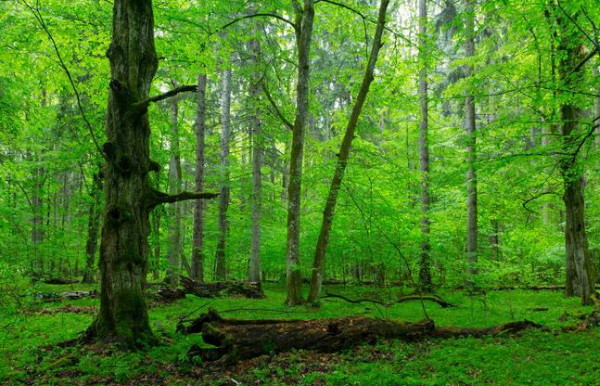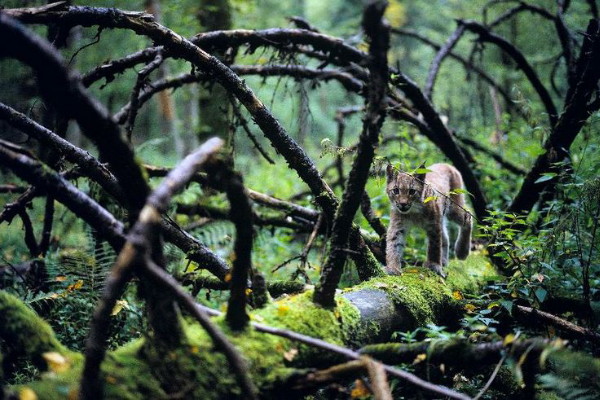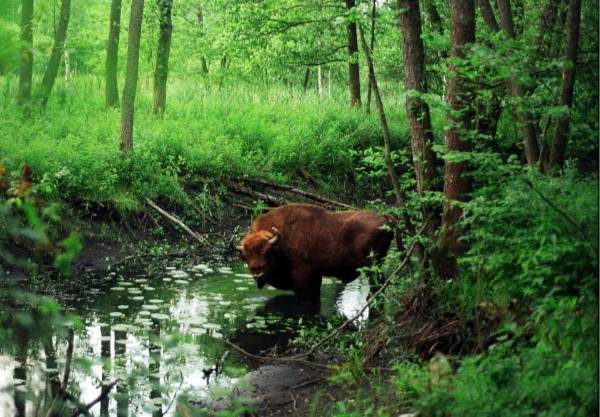Bilovezha Forest
Bilovezha Forest [Біловежська Пуща; Bilovez'ka pušča; Polish: Puszcza Białowieska; Belarusian: Белавежская пуща; Belavezhskaia pušča]. The Bilovezha Forest is the largest stretch of forest in the Central European Lowland. It lies on the border of Podlachia and Polisia, on the watershed between the Narva (Narew) River and the Yaselda River. It overlaps Ukrainian, Belarusian, and Polish ethnic territories. The forest covers about 1,250 sq km. The eastern part (740 sq km) belongs to Belarus; the western part, to Poland. The Bilovezha Forest is a gently undulating plain at an elevation of 150–170 m. The climate is moderately cold. The average annual temperature is 7.4 °C. The annual precipitation is 670 mm. Snow lies on the ground for 70 days. The soil is of glacial origin and consists of sands and clays. There are many swamps. About 82 percent of the Bilovezha Forest is virgin forest, mostly evergreen. The predominant trees are pine, spruce, oak, birch, alder, aspen, maple, ash, and linden. Swamps and peat bogs cover 10 percent of the area. Over 900 plant species grow here. Over 55 animal species inhabit the forest, among them the European bison, elk, wild boar, deer, lynx, wolf, beaver, otter, marten, and squirrel. At the beginning of the 20th century elk could still be found; in the 19th century, wild horse and brown bear; and in the 17th century, aurochs. Over 212 bird species live here, including the great grouse, woodcock, hazel grouse, and black crane.
For centuries the forest received some protection as the hunting grounds of the Polish kings. Under Russian rule the forest was state land, and from 1820 any kind of exploitation of it was prohibited. In 1889 the Bilovezha Forest became the property of the tsar's family, who hunted there from time to time. For this reason the forest was well protected, and many animal species survived there (1,575 European bison in 1860; 700 in 1910). During the First World War the animals were left unprotected, and the European bison were killed off. Between the two wars the Bilovezha Forest was in Polish hands and was moderately exploited, except for a large reserve that was named a national park (46 sq km). In 1929 a few European bison were purchased and kept on an animal reservation (52 ha). In 1939 the number of bison increased to 17. Today the Bilovezha Forest is divided between Poland, which possesses the reserve Białowieża National Park (5,069 ha, of which 4,700 ha are fully protected), and Belarus, where a hunting preserve (8,750 ha) and a natural museum called the Belavezha Forest Museum were set up in 1957.
BIBLIOGRAPHY
Kartsev, G. Belovezhskaia pushcha (Saint Petersburg 1903)
Karpiński, J. Puszcza Białowieska (Warsaw 1953)
Kester, B; Shestak, S. Proshloe i nastoiashchee Belovezhskoi pushchi (Moscow 1968)
Volodymyr Kubijovyč
[This article originally appeared in the Encyclopedia of Ukraine, vol. 1 (1984).]


